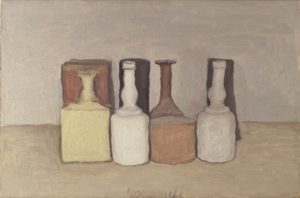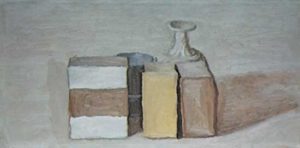At first glance, Giorgio Morandi’s paintings remind you of the Peggy Lee song, “Is That All There Is?” Oh-hum still-lifes of misshapen bottles and little boxes in drab and dusty colors. To make matters worse, the objects are not interestingly arranged. Typically, still-life objects are cunningly placed so as to lead the eye on some small and interesting journey around the tabletop or windowsill.

But no, the Italian modernist doesn’t go in for that sort of visual ploy. He just sticks one thing next to another like a police lineup. Nor does he struggle to create variety in the spaces between the objects, another classic method for putting some life into the lifeless.
In French, still-life is nature morte – literally, dead nature. Morandi seems to have taken that to heart.
In fact, Morandi, who was hailed in Italy as an avant-garde saint when he died in 1964, remained aloof from every one of the traditional motives for painting still-life: to trick the eye with an illusion of three-dimensional space, to celebrate a horn-of-plenty abundance with a feast-like spread, or to remind the viewer with ominous symbols – skulls, hourglasses, dead animals – of death’s imminence.
Nor was he drawn to the cubist program of shattering violins and wine bottles into space-bending facets and shards.
And so, why do these paintings draw you in? Where is the allure in all this perverse dreariness?
 That is the fascinating paradox of the retrospective at the Metropolitan Museum. It’s not a big show – that would be out of character for Morandi, anyway – just one circuit around the lower level of the Robert Lehmann Wing – 110 works. But it’s the Met’s first major fall exhibit and even if you’ve never heard of Morandi, it’s worth going for a look-see.
That is the fascinating paradox of the retrospective at the Metropolitan Museum. It’s not a big show – that would be out of character for Morandi, anyway – just one circuit around the lower level of the Robert Lehmann Wing – 110 works. But it’s the Met’s first major fall exhibit and even if you’ve never heard of Morandi, it’s worth going for a look-see.
Morandi can be curiously soothing in an age of visual overload. And, as with most modernists, the journey can be as interesting – sometimes more interesting – than the finished product. How does an artist end up in such a seeming cul-de-sac and how does he manage to float away when he gets to the end of it?
Morandi was born in Bologna in 1890 and scarcely ever left. He went to art school there, taught elementary school there, and became an etching instructor at the same academy he attended as a youth. He shared an apartment with his three sisters, and was notoriously reclusive, granting only two interviews for publication, both near the end of his life.

He got out of Bologna enough – notably trips to Venice, Florence and Rome – to keep abreast of modernist developments. Early on, he tried on various styles – including an odd series of spheres and other geometrical elements standing in what look like shallow boxes, as if they were storage spaces for a metaphysician.
In truth, he was, like many artists, enormously influenced by Cezanne, but he didn’t want to join the stampede into cubism. He seemed determined to rethink Cezanne from the beginning and set his career on a different path of reductionism. He tried distilling still life objects into geometric purities, as if everything were a solid plaster cast idealized in form. He drained out most of the color, so that his paintings look like washed out frescoes – like those found in churches all over Italy. For a little while, perhaps influenced by Giacometti, he stretched everything tall and thin. Pitchers, bottles, vases – all possessed of giraffe-like necks.
His world of subjects shrank, shrank, shrank until there were just the few squat bottles and boxes. In doing so – and in declining to jazz things up at all — he forces you to look at the banal reality. Here, says Morandi, this is all there is. Just things in space.
He sought, in his own words, “to touch the depth, the essence of things.” And he succeeded to the point where a group of drab – now familiar – objects, huddled together on a shelf can begin to seem somehow… heroic.

